

OCIR's Last Drag Race: The day the music died

(Poster courtesy of Steve McDermott)
|
Oct. 29, 1983. It was a day, 25 years ago today, on which many Southern California racers and race fans mourned, and mourned heavily.
Twenty-five years ago, Oct. 29 was a Saturday, not a Wednesday, and it was the end of an era for race-spoiled SoCal fans who watched their last full-time metropolitan dragstrip, Orange County Int’l Raceway, join the roll call of the dead and the ghost tracks of our memories. Santa Ana, San Fernando, Goleta, Colton, Riverside, Ramona, Paradise Mesa, San Gabriel, Fontana, Lions, Irwindale, OCIR … gone, gone, gone.
Where once dragstrips were nearly as abundant as drive-in theaters, the passing of OCIR left a veritable drag racing desert, and, for the first time in more than 30 years, Southern California, to many the birthplace of hot rodding, had no full-time dragstrips in operation.
It's not really fair to report that "the County" closed up shop Oct. 29 because racing continued well into Oct. 30 with racers praying not to get eliminated to earn another last shot at the fabled quarter-mile and fans hanging on into the wee hours of the morning like jilted lovers, their arms draped hopefully around the neck for one last sweet embrace.
The records show that Gary Beck in Top Fuel and Kenny Bernstein in Funny Car were the last Professional winners at "the County," but no one really felt much like a winner that night.
More than 20 nitro Funny Car teams showed up to say goodbye and to shoot for spots in the eight-car field. John Collins led the field with a 5.91 in his JVC Audio Express Camaro, a car that was tuned at the event by Lee Beard. Bernstein (5.98). Also in the show were John Force (5.99), Billy Meyer (6.02), Mark Oswald in the Candies & Hughes/Trans Am (6.03), Mike Dunn (6.05, with an EXP body borrowed from Meyer atop the chassis that he'd rolled at the World Finals two weeks earlier), Raymond Beadle (6.09), and Don Prudhomme (6.11) in the bump spot. The track had run a big bracket meet the weekend before and its usual Wednesday night grudge matches, so traction wasn't up to the numbers dished out two weeks earlier at the World Finals.
As strong and deserving a field as that was for the fans, there still seemed little justice that longtime OCIR racers such as Joe Pisano (who with driver Tripp Shumake had won OCIR's 64 Funny Cars race earlier that year and missed this field by two-thousandths of a second), Tom McEwen, Jim Dunn, Gary Densham, Dale Pulde, Mert Littlefield, Rodney Flournoy, and Henry Harrison didn't make the last show, but they and others were given the chance to run singles later in the evening.
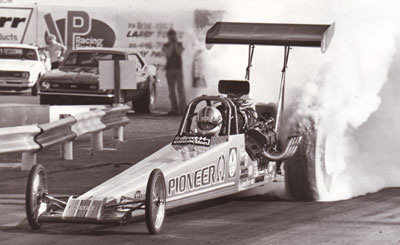
All of the stars came out for the Last Drag Race, including three-time NHRA Top Fuel champ Shirley Muldowney, who had won the NHRA World Finals two weeks earlier at "the County."
|
In round one, Oswald red-lighted to Collins, and Bernstein blasted a 5.92 to beat Mike Dunn and Force a 5.94 to beat Beadle, but Meyer topped 'em all with low e.t. of the meet for the floppers, 5.89, in dismissing "the Snake." Collins then died by the same sword, fouling to Force, and Bernstein ousted fellow Texan Meyer with a 5.97 to set up the final.
Top Fuel likewise was chock-full of marquee names among the 19 trying to qualify. Larry Minor led the eight-car field with a 5.58, low e.t. of the meet but a far cry from the 5.39 that teammate Beck had run just two weeks earlier. Doug Kerhulas (5.82), Shirley Muldowney (5.83), and national speed record holder Rocky Epperly (5.88) made up the quick four. Ray Stutz (5.89), Marc Cornelius (5.99), and Dwight Salisbury (6.01) grabbed the next three spots, and Beck, of all people, was on the bubble with an engine-wounding 6.01. Minor, however, had winged the crankshaft on his 5.58, which allowed first alternate Don Durbin (6.06) into the show.
Epperly beat Salisbury with a 247.93-mph speed, top speed of the meet; Cornelius red-lighted to Kerhulas; and Stutz smoked 'em against Durbin. The race's marquee matchup, between 1983 NHRA season champ Beck and 1982 champ Muldowney, had the fans on their feet, but it was Beck all the way, 5.73 to 6.06.
Beck improved to a 5.69 in round two to send Durbin home, and Kerhulas joined him in the final with a 5.73 at just 227.84 mph, death smoke pouring from the pipes.
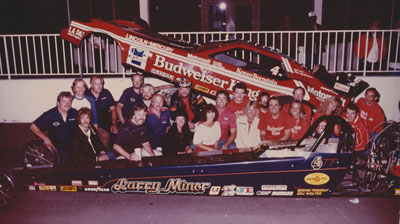
The crews of Gary Beck and Kenny Bernstein, the final winners in Top Fuel and Funny Car, respectively, at OCIR, posed in the Last Drag Race winner's circle with owner Charlie Allen and starter Larry Sutton.
|
Kerhulas was unable to repair his damage, and at 1:25 a.m., Beck laid down a half-track burnout that was followed by a great 5.59, 245.23 solo for the final Top Fuel title.
Twenty minutes later, the Funny Car final rolled to the line at 1:45 a.m. Force smoked the hoops, but, in typical Force fashion, he never lifted and was right with KB when he, too, had traction woes. Bernstein got to the finish line first, 6.13 to 6.22.
The final set of supercharged cars down the OCIR quarter-mile featured those driven by Mike Andreotti, who had upset OCIR king Brad Anderson in round one, and the "Boogie Man," Wayne Stoeckel. The nod went to the Andreotti Bros. Monza, 6.61 to 6.75.
Unlike at Lions' Last Drag Race, where the Top Fuel final between Carl Olson and Jeb Allen was the last competition down the track and fans ran wild in its aftermath, E.T. racing, which began with more than 300 cars, continued for more than an hour after the headliner finals. Tom Wilkinson won Bracket 4, Randy Gillis took Bracket 3, and Guss Barks Jr. banked Bracket 2 honors. OCIR Pro Gas veteran Gary Cooke and Terry White split Bracket 1 honors after everyone just grew too tired to complete a race that began with 168 cars in the class.
I caught up yesterday with Charlie Allen, who owned OCIR then and today continues to serve up match race madness at Firebird Int'l Raceway in Arizona, and he confirmed that the anticlimactic finish was part the plan.
"I had heard all kinds of rumors that people were going to tear the place apart for souvenirs like they did at Lions, so our plan was to outlast them," he admitted. "We didn’t think it would run that late, but there were a lot of cars because everyone wanted to be at the Last Drag Race. By the time we did finish, the 200 people who were still there were too tired to do anything. The stands were virtually empty."
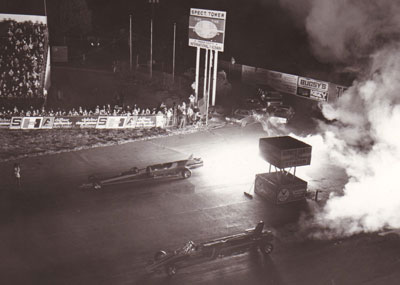
This isn't the infamous Larry Sutton arson incident mentioned in the text, but it gives you an idea of what was to come.
|
The exhibition acts were the jet dragsters of Scott Hammack, Bill Holevas, Bill Carter, and Doug Brown and Ed "the Outlaw" Jones' Jolly Rancher stage coach wheelstander; at one point, chief starter Larry Sutton backed two of them up to the burnout shack between the lanes and tried to set it alight, which was just about the only real damage done to the old gal that night.
"I guess they lined up a little crooked," Sutton deadpanned to me when I asked him about it last week. "No, it was totally planned, and the drivers were in on it, and the flames were just blasting off the tower until Charlie came down and said, 'What are you doing?' "
Sutton actually was the chief starter at all three of SoCal's best-remembered tracks – Lions, Irwindale, and OCIR – when they closed, and losing "the County" hurt.
"Losing Lions was totally an emotional deal for me because that's where I grew up. I liked Irwindale a lot, but losing Orange County had a lot of meaning for me, too, because I thought it was the end of the line for me as a starter. It also was my hometown track, so it was tough to see it go."
Mike McClelland, son of legendary drag racing announcer Dave McClelland, who began announcing bracket races at the track the previous August ("I was okay," he admits of his microphone skills, "but wasn’t about to make anybody forget 'Big Mac,' but it was a great college job.") remembers the sad day well.
"We knew pretty early that it was going to be a long night," he said. "There were more cars than I had ever seen at the place, and every fuel car within any reasonable towing distance was there, and I don’t remember how we got all the bracket cars parked. I know there were plenty of cars down in the grass area toward the end of the track
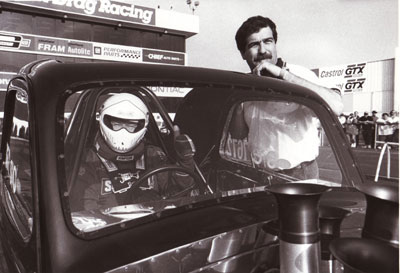
Mike McClelland, right, who announced at OCIR during its final two seasons, is one of many who remembers well the Last Drag Race. He's pictured here with his famous father, veteran NHRA announcer Dave, who was preparing to run his Tuna Tank Fiat at the 1997 Winternationals.
|
"I didn’t have much to do during the day and into the evening, but I think anybody who had ever spent any time on the mic in Southern California was there at one point or another – my dad, Steve Evans, Richard Schroeder, Bernie Partridge. I just got to sit and watch and listen. Steve was there until the end of the nitro cars and called Gary Beck’s Top Fuel win.
"The 11 p.m. curfew came and went. I remember yelling downstairs to [track manager] Kenny Green, 'What are we going to do?' and he pretty much started laughing and said something to the effect of, 'What are THEY going to do, shut us down?'
"We ran something like five rounds of Super Pro after the fuel cars were done. The last pair went down the track sometime around 3 a.m. Strangely, when it all finally ended, it just kind of ended. I think the fact that most of us had been there for about 18 hours had something to do with it, but to the best of my recollection, we just kind of sat there in the tower. It was just the regular tower staff -- Mary Chase, Pam Sutton, Joanne Talley, and my announcing partner Kirk Peters -- and nobody said much. We closed things up and went home.
"Frankly, the last Wednesday night [grudge night] was much more emotional. The Wednesday night crew was pretty close-knit, with Jeannie Weichmann, Bob Vrbancic, and some of the regular racers stopping every week at that culinary hot spot the Westminster Café (still there 25 years later) after we were done. That last Wednesday at the Westminster, nobody wanted to leave.
"Except for a brief Friday morning hour at the 1984 Winternationals, I never announced another drag race. Less than two weeks after the track closed, I started my first 'real' job after college, covering Pennzoil’s field operations for the Racing Department. Interestingly enough, less than four years after the track closed, I was working for Mazda in their corporate-headquarters building that sits smack in the middle of where the one-lane road went through the strawberry fields. So I pretty much had a front-row seat of the land being developed. And I didn’t like it one bit."
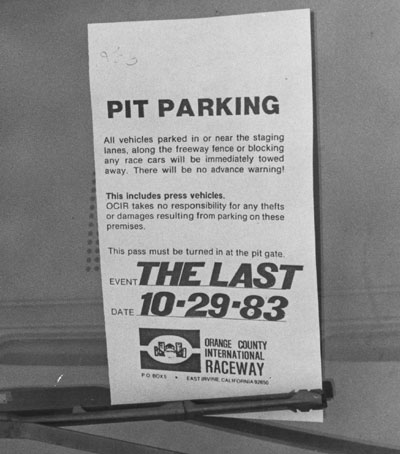 |
I remember it all very clearly, even 25 years later. I remember standing in the photographer's area with the late, great Leslie Lovett, ubiquitous drag racing guru Dave Wallace, and veteran lensman Tim Marshall soaking up the very last minutes of it. They were tearing down our clubhouse, the regular gathering place of SoCal motorsports journalists for years. Les and I got in the car and started cruising the pits, looking for any excuse to talk to someone, compare old memories, and somehow delay the inevitable. All day, rumors had spread through the pits that Allen had wrangled another year (or two or three, depending on who was telling it) from the Irvine Co. or that Allen was going to pull a Son of Last Drag Race card from his sleeve as he had done for the final 64 Funny Cars race, but that sadly wasn't the case.
I remember us driving out the exit road and stopping atop the one-lane bridge that crossed the freeway, getting out of the car, and taking one last look at "the County."
Twenty-five years ago, I wrote these words for our coverage of the race: "The entire area around the track was pitch black, but the track's high-intensity light shone brightly, silhouetting the empty main grandstands and the distinctive tower. It was a breathtaking sight. Then we turned and drove away. And then there were none."
Friday: OCIR Week concludes with "The rise and fall of Orange County Int'l Raceway"



















































